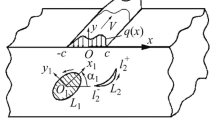We solve the stationary problem of heat conduction and thermoelasticity for an infinite body with two identical coplanar thermally active circular cracks on which a temperature or heat flow is given. By using harmonic potentials of a simple and double layer, we reduce the problem to singular integral equations with regular kernels. If the distance between the centers of the cracks is larger than the sum of their radii, then we replace the regular kernels by degenerate kernels and obtain the exact solutions of the equations the right-hand sides of which are polynomials of the second degree. The components of the stress tensor and stress intensity factors are determined.
Similar content being viewed by others
References
A. E. Andreikiv, Space Problems of the Theory of Cracks [in Russian], Naukova Dumka, Kiev (1982).
G. S. Kit and O. P. Sushko, “Thermoelastic state of a body with two coplanar or parallel thermally active cracks,” Teoret. Prikl. Mekh., Issue 40, 3–8 (2005).
G. S. Kit and M. V. Khai, Method of Potentials in Three-Dimensional Problems of Thermoelasticity of Bodies with Cracks [in Russian], Naukova Dumka, Kiev (1989).
H. S. Kit, “Problems of stationary heat conduction and thermoelasticity for a body with heat release on a circular domain (crack),” Mat. Met. Fiz.-Mekh. Polya, 51, No. 4, 120–128 (2008); English translation: J. Math. Sci., 167, No. 2, 141–153 (2010).
H. S. Kit and O. P. Sushko, “Axially symmetric problems of stationary heat conduction and thermoelasticity for a body with thermally active or thermally insulated disk inclusion (crack),” Mat. Met. Fiz.-Mekh. Polya, 53, No. 1, 58–70 (2010); English translation: J. Math. Sci., 176, No. 4, 561–577 (2011).
V. V. Panasyuk, Mechanics of Quasibrittle Fracture of Materials [in Russian], Naukova Dumka, Kiev (1991).
M. P. Savruk, Stress Intensity Factors in Bodies with Cracks [in Russian], in: V. V. Panasyuk (editor), Fracture Mechanics and Strength of Materials. A Handbook, Vol. 2, Naukova Dumka, Kiev (1988).
M. V. Khai, Two-Dimensional Integral Equations of the Newton Potential Type and Their Applications [in Russian], Naukova Dumka, Kiev (1993).
E. Deutch, “The distribution of axisymmetric thermal stress in an infinite elastic medium containing a penny-shaped crack,” Int. J. Eng. Sci., 3, No. 5, 485–490 (1965).
W. S. Fu, “Thermal stresses in an elastic solid weakened by two coplanar circular cracks,” Int. J. Eng. Sci., 11, 317–330 (1973).
M. Isida, K. Hirota, H. Noguchi, and T. Yoshida, “Two parallel elliptic cracks in an infinite solid subjected to tension,” Int. J. Fract., 27, No. 1, 31–48 (1985).
M. K. Kassir and G. C. Sih, Mechanics of Fracture, Vol. 2: Three-Dimensional Crack Problems, Noordhoff, Leyden (1975).
V. S. Kirilyuk, ”Thermostressed state of a piezoelectric body with a plane crack under symmetric thermal load,” Prikl. Mekh., 44, No. 3, 96–108 (2008); English translation: Int. Appl. Mech., 44, No. 3, 320–330 (2008).
Z. Olesiak and I. N. Sneddon, “The distribution of thermal stress in an infinite elastic solid containing a penny-shape crack,” Arch. Ration. Mech. Anal., 4, No. 3, 238–254 (1960).
R. Shail, “Some thermoelastic stress distributions in an infinite solid and a thick plate containing a penny-shaped crack,” Mathematika, 11, No. 2, 102–118 (1964).
R. A. Tomlinson and E. J. Olden, “Thermoelasticity for the analysis of crack tip stress fields—a review,” Strain, 35, No. 2, 49–55 (1999).
S. Ueda and K. Ikawa, “Thermoelectromechanical interaction between two parallel cracks in a piezoelectric strip,” J. Therm. Stresses, 31, No. 4, 311–330 (2008).
S. Ueda and Y. Tani, “Thermal stress intensity factors for two coplanar cracks in a piezoelectric strip,” J. Therm. Stresses, 31, No. 5, 403–415 (2008).
Author information
Authors and Affiliations
Additional information
Translated from Matematychni Metody ta Fizyko-Mekhanichni Polya, Vol. 55, No. 1, pp. 84–94, January–March, 2012.
Rights and permissions
About this article
Cite this article
Sushko, O.P. Thermoelastic state of a body with two coplanar thermally active circular cracks. J Math Sci 190, 725–739 (2013). https://doi.org/10.1007/s10958-013-1283-z
Received:
Published:
Issue Date:
DOI: https://doi.org/10.1007/s10958-013-1283-z




